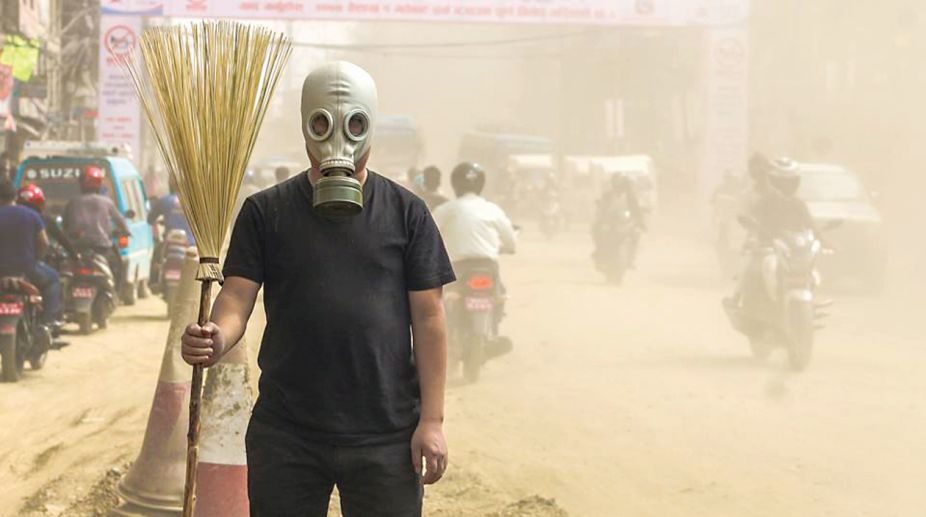In March 2017, the statue of Late King Mahendra Shah stood in the middle of Kathmandu Valley with an anti-pollution mask on. This was a creative take on protests against air pollution, and it drew attention to the deplorable levels of pollution in Kathmandu Valley, which is inhabited by over 2.5 million people.
The effect of poisonous gases emitted by the burning of fossil fuels from motor vehicles and industries is compounded by dust emitted from construction activities – particularly road expansion and the laying of the Melamchi drinking water pipeline.
Advertisement
The situation is even worse during winter months – a period of temperature inversion. Unable to escape outside the bowl-shaped valley, the pollutants form smog and descend downwards.
A report prepared by researchers at Yale and Columbia Universities in association with the World Economic Forum showed that Nepal falls in the bottom five on the 2018 Environmental Performance Index (EPI) out of a total of 180 countries. This means that Nepal suffers from poor public health and an inability to manage natural resources and emissions of greenhouse gases.
It also shows the need for national sustainability efforts on cleaning up air quality, protecting biodiversity, and reducing Green House Gas (GHG) emissions. Air pollution causes headaches, coughs, and sneezing, and long-term exposure causes asthma, pneumonia and lung cancer.
A paper presented by Karki and friends at a National Conference on Science and Technology showed that about 15 per cent of the pneumonia cases in Kathmandu are attributed to air pollution. Similarly, according to Department of Health Service, in 2015/16, 8,909 people died from pneumonia and 7,837 from respiratory infections.
Emissions from the increasing number of vehicles are responsible for poisoning the Valley air. Vehicles in Nepal still use leaded fuel, which releases the hazardous heavy metal, lead, into the air. In particular, the lemons plying the Capital are amongst the biggest culprits behind air pollution. Lemons refer to vehicles with very low efficiency.
The rate of increase of vehicles in Kathmandu Valley has been tremendous. In fiscal year 2016/17, the Bagmati Zone alone registered 119,956 vehicles. The total number of registered vehicles in the Bagmati Zone alone reached 1,042,856 in 2016/17 from only 330,956 vehicles in 2006/07.
In addition to the vehicles registered in this zone, vehicles registered in other zones also ply the roads of the Valley and are equally responsible for polluting the air. With the increase in the number of vehicles, the use of petroleum fuel has also increased.
One way to control pollution from motor vehicles is to regularly monitor their emissions. Yearly monitoring does not ensure reduced emissions, there is a need for regular – possibly trimester-wise – monitoring to achieve positive results. Adulteration of fuel is another major problem we face.
Kerosene and other chemicals are mixed with petrol at different levels for profit. Such adulteration, however, reduces engine efficiency and emits a greater volume of carbon into the atmosphere. Though efforts have been made to minimise adulteration by reducing the price discrepancy between diesel and kerosene, such practices still occur.
Unmanaged traffic is another source of pollution. Every minute spent in traffic congestion contributes to carbon emission. The problem is that Kathmandu lacks traffic lights except in sections of the Kathmandu-Bhaktapur road.
When the traffic is managed by the traffic police alone, without an automatic signal system, both the police and the motorists are stressed, and congestion and the resultant emissions also increase. An automated system would help reduce emissions.
Well-off people have the capacity to deal with the problem of air pollution. They can afford the use of air conditioners and air purifiers and can spend less time outdoors. However, a majority of the population do not have access to these luxuries. They also have to spend most of their time outdoors.
This less privileged section of the population tries to avoid polluted air by using anti-pollution masks. The problem is that these masks are usually prepared using ordinary cotton clothes or synthetic sponges, which do not have the capacity to filter out smaller life-threatening pollution particles. Many people live with a false sense of security that these masks filter out all kinds of pollutants and that they are safe just by using them.
There is an urgent need to educate the public on issues related to air pollution, its causes, and its effect on their health. The government also needs to devise policies to ban the import of leaded petroleum products and exempt tax on vehicles that run on clean energy so as to minimise the use of fossil fuels.
Initiatives must be established to implement efficient traffic signals across the valley. Banning old vehicles is one approach but it does not guarantee clean air as today’s need is for regular engine check-ups, cleaner fuel and less time spent in traffic.
The Kathmandu Post/ANN.











